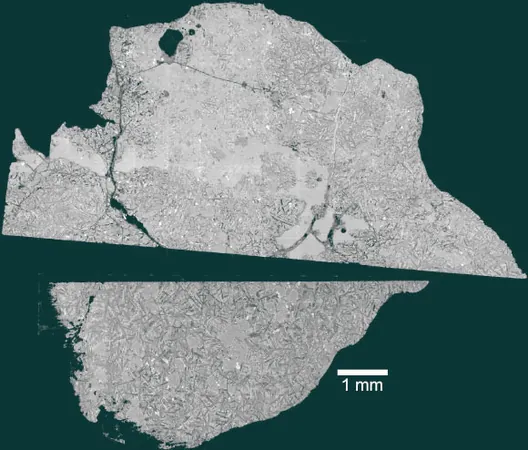
Ancient Lunar Meteorite Unlocks Secrets of Moon's Volcanic Past
2025-07-09
Author: Emma
A 2.35-Billion-Year-Old Mystery Revealed
Exciting new research on a recently discovered lunar meteorite, Northwest Africa (NWA) 16286, is shedding light on the Moon's volcanic history, bridging a staggering one-billion-year gap in our understanding of its geological evolution.
A Rare Find from the Moon
Unearthed in Africa in 2023, NWA 16286 is a 311-gram treasure, one of only 31 lunar basalts known to exist on Earth. Its unique chemical profile suggests it experienced a dramatic history, possibly being jolted by an asteroid impact on the Moon's surface before being ejected into space.
Unraveling the Moon's Interior
Researchers from the University of Manchester have conducted a detailed analysis of this celestial specimen, revealing that the Moon has maintained internal heat-generating processes, fueling volcanic activity across various phases.
A Peek into the Ancient Past
Lead isotope analysis dates the formation of this rock to approximately 2.35 billion years ago—an age that fills a critical gap in the lunar volcanic timeline. "This makes it the youngest basaltic lunar meteorite ever identified on Earth," notes Dr. Joshua Snape from the University of Manchester.
Uniqueness of NWA 16286
The meteorite's distinct chemical makeup includes pockets of molten glass and veins, setting it apart from previous samples obtained from lunar missions. This suggests that it solidified from a lava flow that originated deep within the Moon.
Why This Matters
Dr. Snape emphasizes the significance of lunar meteorites: unlike samples collected during space missions, which are restricted to specific landing areas, meteorites can provide insights from various regions on the Moon's surface. This serendipitous find has the potential to reveal secrets of lunar geology without the astronomical costs of space exploration.
The Implications of the Discovery
With large crystals of olivine, NWA 16286 is a type of volcanic basalt enriched with titanium and potassium. Its geochemical fingerprint indicates a source rich in uranium, hinting at ongoing heat generation mechanisms related to radioactive decay.
Looking to the Future
This discovery will not only refine our understanding of lunar volcanic activity but will also help pinpoint future landing sites for sample return missions. As Dr. Snape states, "There's much more to learn about the Moon’s geological past, and this rock will guide our explorations ahead."
Presenting Groundbreaking Research
The findings from this study were featured at the Goldschmidt Conference 2025 held in Prague, Czech Republic, spotlighting the ongoing quest to unlock the Moon's mysteries.









 Brasil (PT)
Brasil (PT)
 Canada (EN)
Canada (EN)
 Chile (ES)
Chile (ES)
 Česko (CS)
Česko (CS)
 대한민국 (KO)
대한민국 (KO)
 España (ES)
España (ES)
 France (FR)
France (FR)
 Hong Kong (EN)
Hong Kong (EN)
 Italia (IT)
Italia (IT)
 日本 (JA)
日本 (JA)
 Magyarország (HU)
Magyarország (HU)
 Norge (NO)
Norge (NO)
 Polska (PL)
Polska (PL)
 Schweiz (DE)
Schweiz (DE)
 Singapore (EN)
Singapore (EN)
 Sverige (SV)
Sverige (SV)
 Suomi (FI)
Suomi (FI)
 Türkiye (TR)
Türkiye (TR)
 الإمارات العربية المتحدة (AR)
الإمارات العربية المتحدة (AR)